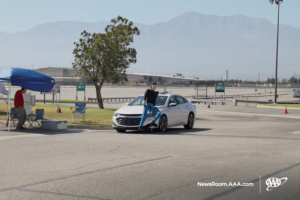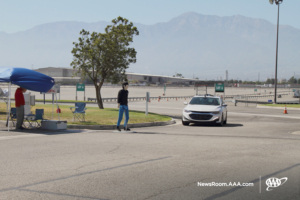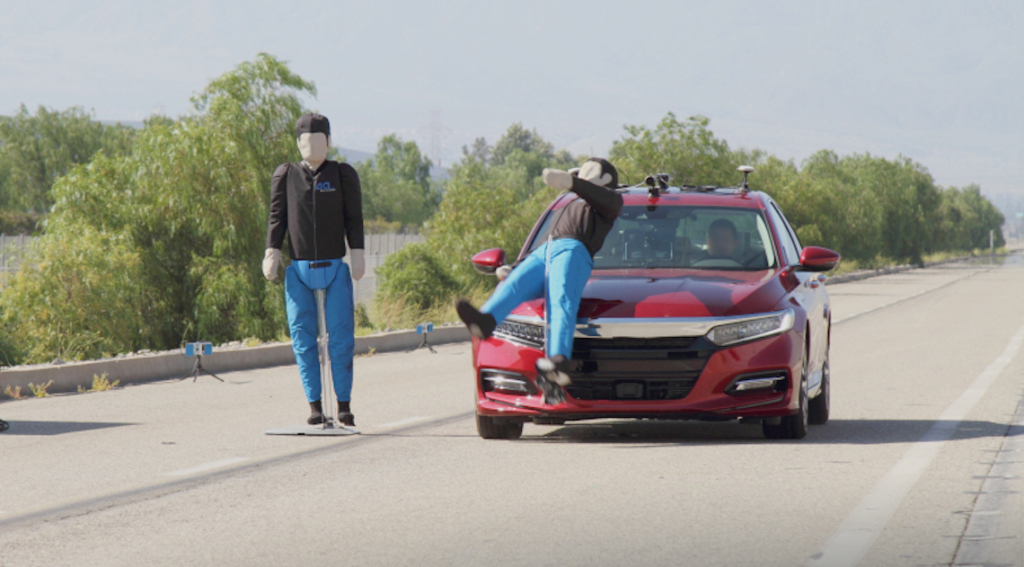New research from AAA reveals that automatic emergency braking systems with pedestrian detection perform inconsistently, and proved to be completely ineffective at night. An alarming result, considering 75% of pedestrian fatalities occur after dark. The systems were also challenged by real-world situations, like a vehicle turning right into the path of an adult. AAA’s testing found that in this simulated scenario, the systems did not react at all, colliding with the adult pedestrian target every time.
 For the safety of everyone on the road, AAA supports the continued development of pedestrian detection systems, specifically when it comes to improving functionality at night and in circumstances where drivers are most likely to encounter pedestrians. On average, nearly 6,000 pedestrians lose their lives each year, accounting for 16% of all traffic deaths, a percentage that has steadily grown since 2010.
For the safety of everyone on the road, AAA supports the continued development of pedestrian detection systems, specifically when it comes to improving functionality at night and in circumstances where drivers are most likely to encounter pedestrians. On average, nearly 6,000 pedestrians lose their lives each year, accounting for 16% of all traffic deaths, a percentage that has steadily grown since 2010.
“Pedestrian fatalities are on the rise, proving how important the safety impact of these systems could be when further developed,” said Greg Brannon, AAA’s director of Automotive Engineering and Industry Relations. “But, our research found that current systems are far from perfect and still require an engaged driver behind the wheel.”
While time of day and location are contributing factors to pedestrian fatalities, vehicle speed also plays a major role. Previous research from the AAA Foundation for Traffic Safety found that pedestrians are at greater risk for severe injury or death the faster a car is traveling at the time of impact. For example, a pedestrian hit by a vehicle traveling at 20 mph has an 18% risk of severe injury or death. Increase that by just 10 mph to 30 mph and the risk more than doubles to 47%. AAA’s latest study found that speed impacted system performance as well, with results varying between testing performed at 20 mph and 30 mph.
 In partnership with the Automobile Club of Southern California’s Automotive Research Center, AAA evaluated the performance of four midsize sedans equipped with automatic emergency braking with pedestrian detection to determine the effectiveness of these systems. Testing was conducted on a closed course using simulated pedestrian targets for the following scenarios:
In partnership with the Automobile Club of Southern California’s Automotive Research Center, AAA evaluated the performance of four midsize sedans equipped with automatic emergency braking with pedestrian detection to determine the effectiveness of these systems. Testing was conducted on a closed course using simulated pedestrian targets for the following scenarios:
- An adult crossing in front of a vehicle traveling at 20 mph and 30 mph during the day and at 25 mph at night.
- A child darting out from between two parked cars in front of a vehicle traveling at 20 mph and 30 mph.
- A vehicle turning right onto an adjacent road with an adult crossing at the same time.
- Two adults standing along the side of the road with their backs to traffic, with a vehicle approaching at 20 mph and 30 mph.
Overall, the systems performed best in the instance of the adult crossing in front of a vehicle traveling at 20 mph during the day. In this case, the systems avoided a collision 40% of the time. But, at the higher speed of 30 mph, most systems failed to avoid a collision with the simulated pedestrian target. The other scenarios proved to be more challenging for the systems:
- When encountering a child darting from between two cars, with the vehicle traveling at 20 mph, a collision occurred 89% of the time.
- Immediately following a right hand turn, all of the test vehicles collided with the adult pedestrian.
- When approaching two adults standing alongside the road, with the vehicle traveling at 20 mph, a collision occurred 80% of the time.
- In general, the systems were ineffective in all scenarios where the vehicle was traveling at 30 mph.
- At night, none of the systems detected or reacted to the adult pedestrian.
“The rise in pedestrian deaths is a major concern and automakers are on the right path with the intent of these systems,” continued Brannon. “Our goal with this testing is to identify where the gaps exist to help educate consumers and share these findings with manufacturers to work to improve their functionality.”
New vehicle technology can alert drivers and assist in lessening the likelihood or severity of a crash – whether with another vehicle or even more importantly, a pedestrian. But, until these systems are proven to perform consistently – especially pedestrian detection systems – during the day and at night and in a range of situations, AAA recommends drivers always:
- Be alert of their immediate surroundings. Do not rely on pedestrian detection systems to prevent a crash. This technology should only serve as a backup and not a replacement for an engaged driver.
- Read the owner’s manual to understand what safety systems the vehicle is equipped with. Before leaving the lot, ask the dealer to explain how these systems work, including what safety system alerts sound and look like and what triggers their activation.
- Use extra caution when driving at night since this is the riskiest time for pedestrians and where the systems struggled the most. Previous AAA research found that headlights, even in new condition, do not provide the amount of light needed for drivers to appropriately react to something or someone in the roadway.
It is a driver’s responsibility to yield to pedestrians, but those traveling by foot should be diligent as well. Pedestrians should use caution by staying on sidewalks and using crosswalks as often as possible. Always obey traffic signals, look both ways before crossing the street and do not walk and text.
Methodology
To assess the capabilities of pedestrian detection systems, AAA conducted primary research in partnership with the Automotive Club of Southern California’s Automotive Research Center in Los Angeles, California. Track testing was conducted on closed surface streets on the grounds of the Auto Club Speedway in Fontana, California.
Four test vehicles were selected (2019 Chevy Malibu, 2019 Honda Accord, 2019 Tesla Model 3 and 2019 Toyota Camry) using specific criteria and each test vehicle was outfitted using industry-standard instrumentation, sensors and cameras to capture vehicle dynamics, position data and visual notifications from the pedestrian detection system. Three simulated pedestrian targets were used including two dynamic models and each was outfitted with industry-standard instrumentation to time movement as well as receive position, speed and acceleration from the dynamic target. The complete methodology can be found in the full research report here.
